Azure Service Bus

Azure Service Bus is a fully managed enterprise message broker with message queues and publish-subscribe topics (in a namespace) used for decoupling applications and services from each other. This integration helps in monitoring incoming/outgoing messages, connections, throttled requests, and resource usage of your Service Bus namespace.
Log and metric types
For Azure Service Bus, you can collect the following logs and metrics:
- Operational Logs. To learn more about the resource log schema for Azure Service Bus, refer to the Azure documentation.
- VNet And IP Filtering Logs. To learn more about the resource log schema for Azure Service Bus, refer to the Azure documentation.
- Runtime Audit Logs. To learn more about the resource log schema for Azure Service Bus, refer to the Azure documentation.
- Diagnostic Error Logs. To learn more about the resource log schema for Azure Service Bus, refer to the Azure documentation.
- Platform Metrics for Azure Service Bus. These metrics are available in Microsoft.ServiceBus/namespaces namespace. For more information on supported metrics and dimensions, refer to the Azure documentation.
Setup
Azure service sends monitoring data to Azure Monitor, which can then stream data to Eventhub. Sumo Logic supports:
- Logs collection from Azure Monitor using our Azure Event Hubs source.
- Metrics collection using our Azure Metrics Source.
You must explicitly enable diagnostic settings for each Azure Service Bus namespace you want to monitor. You can forward logs to the same Event Hub provided they satisfy the limitations and permissions as described here.
When you configure the Event Hubs source or HTTP source, plan your source category to ease the querying process. A hierarchical approach allows you to make use of wildcards. For example: Azure/ServiceBus/Logs, Azure/ServiceBus/Metrics.
Configure collector
Create a hosted collector if not already configured and tag the tenant_name field. You can get the tenant name using the instructions here. Make sure you create the required sources in this collector. 
Configure metrics collection
To set up the Azure Metrics source in Sumo Logic, refer to Azure Metrics Source.
Configure logs collection
In this section, you will configure a pipeline for shipping diagnostic logs from Azure Monitor to an Event Hub.
Diagnostic logs
- To set up the Azure Event Hubs source in Sumo Logic, refer to Azure Event Hubs Source for Logs.
- To create the Diagnostic settings in the Azure portal, refer to the Azure documentation. Perform the steps below for each Azure Service Bus namespace that you want to monitor.
- Choose
Stream to an event hubas the destination. - Select
allLogs. - Use the Event Hub namespace and Event Hub name configured in the previous step in the destination details section. You can use the default policy
RootManageSharedAccessKeyas the policy name. - Use the Event Hub namespace and Event Hub name configured in the previous step in the destination details section. You can use the default policy
RootManageSharedAccessKeyas the policy name.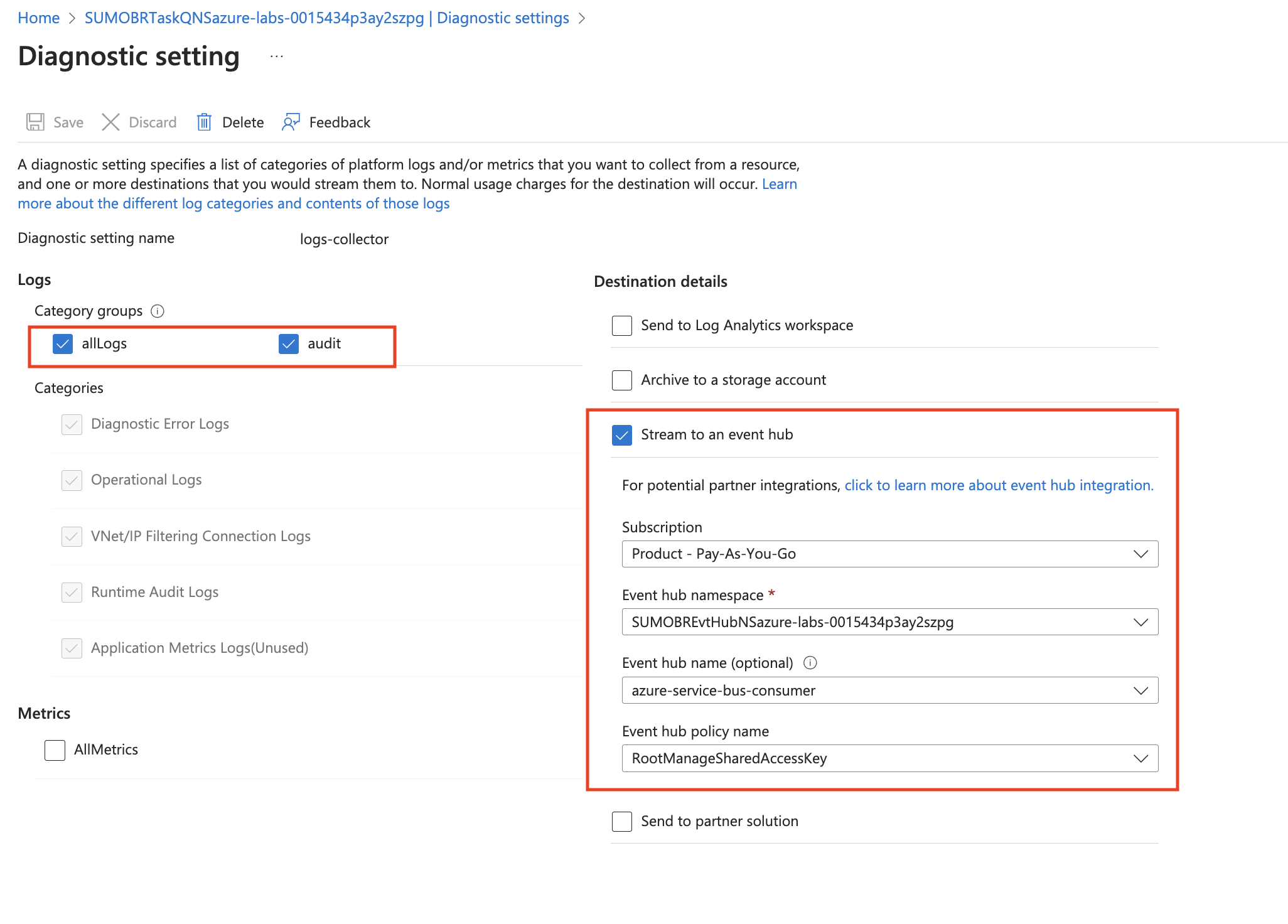
- Choose
- Tag the location field in the source with the right location value.
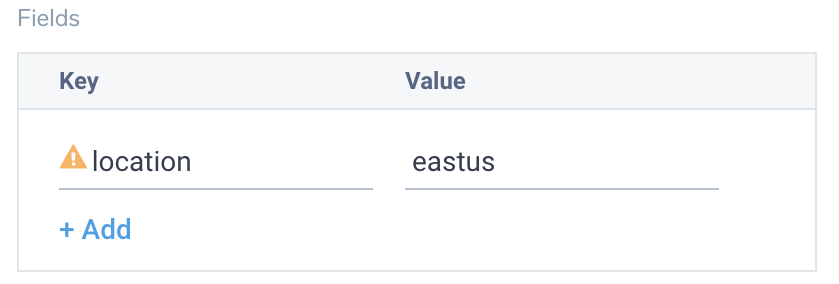
Activity logs (optional)
To collect activity logs, follow the instructions here. If you are already collecting activity logs for a subscription, you can skip this step.
Since this source includes logs from multiple regions, do not tag it with the location tag.
Installing the Azure Service Bus app
Now that you have set up data collection, install the Azure Service Bus Sumo Logic app to use the pre-configured dashboards that provide visibility into your environment for real-time analysis of overall usage.
To install the app, do the following:
Next-Gen App: To install or update the app, you must be an account administrator or a user with Manage Apps, Manage Monitors, Manage Fields, Manage Metric Rules, and Manage Collectors capabilities depending upon the different content types part of the app.
- Select App Catalog.
- In the 🔎 Search Apps field, run a search for your desired app, then select it.
- Click Install App.
note
Sometimes this button says Add Integration.
- Click Next in the Setup Data section.
- In the Configure App section of your respective app, complete the following field.
- Index. Specify value for _index if the collection is configured with custom partition. Learn more. Default value is set to
sumologic_default(default partition)
- Index. Specify value for _index if the collection is configured with custom partition. Learn more. Default value is set to
- Click Next. You will be redirected to the Preview & Done section.
Post-installation
Once your app is installed, it will appear in your Installed Apps folder, and dashboard panels will start to fill automatically.
Each panel slowly fills with data matching the time range query received since the panel was created. Results will not immediately be available but will be updated with full graphs and charts over time.
As part of the app installation process, the following fields will be created by default:
tenant_name. This field is tagged at the collector level. You can get the tenant name using the instructions here.location. The region the resource name belongs to.subscription_id. ID associated with a subscription where the resource is present.resource_group. The resource group name where the Azure resource is present.provider_name. Azure resource provider name (for example, Microsoft.Network).resource_type. Azure resource type (for example, storage accounts).resource_name. The name of the resource (for example, storage account name).service_type. The type of service that can be accessed with an Azure resource.service_name. Services that can be accessed with an Azure resource (for example, in Azure Container Instances, the service is Subscriptions).
Viewing the Azure Service Bus dashboards
All dashboards have a set of filters that you can apply to the entire dashboard. Use these filters to drill down and examine the data to a granular level.
- You can change the time range for a dashboard or panel by selecting a predefined interval from a drop-down list, choosing a recently used time range, or specifying custom dates and times. Learn more.
- You can use template variables to drill down and examine the data on a granular level. For more information, see Filtering Dashboards with Template Variables.
- Many of the Next-Gen apps allow you to provide the Index at the installation time and a default value for this key (sumologic_default). Based on your input, the app dashboards will be parameterized with a dashboard variable, allowing you to change the data partition queried by all panels. This restricts the query scope of all the dashboard queries to a specific data partition.
Overview
The Azure Service Bus - Overview provides details on the overall performance and usage of your Azure Service Bus namespaces.
Use this dashboard to:
- Monitor namespace resource utilization like CPU and memory usage across different locations.
- Track message processing trends by analyzing incoming vs outgoing message differences, total errors and Average Server Send Latency over time.
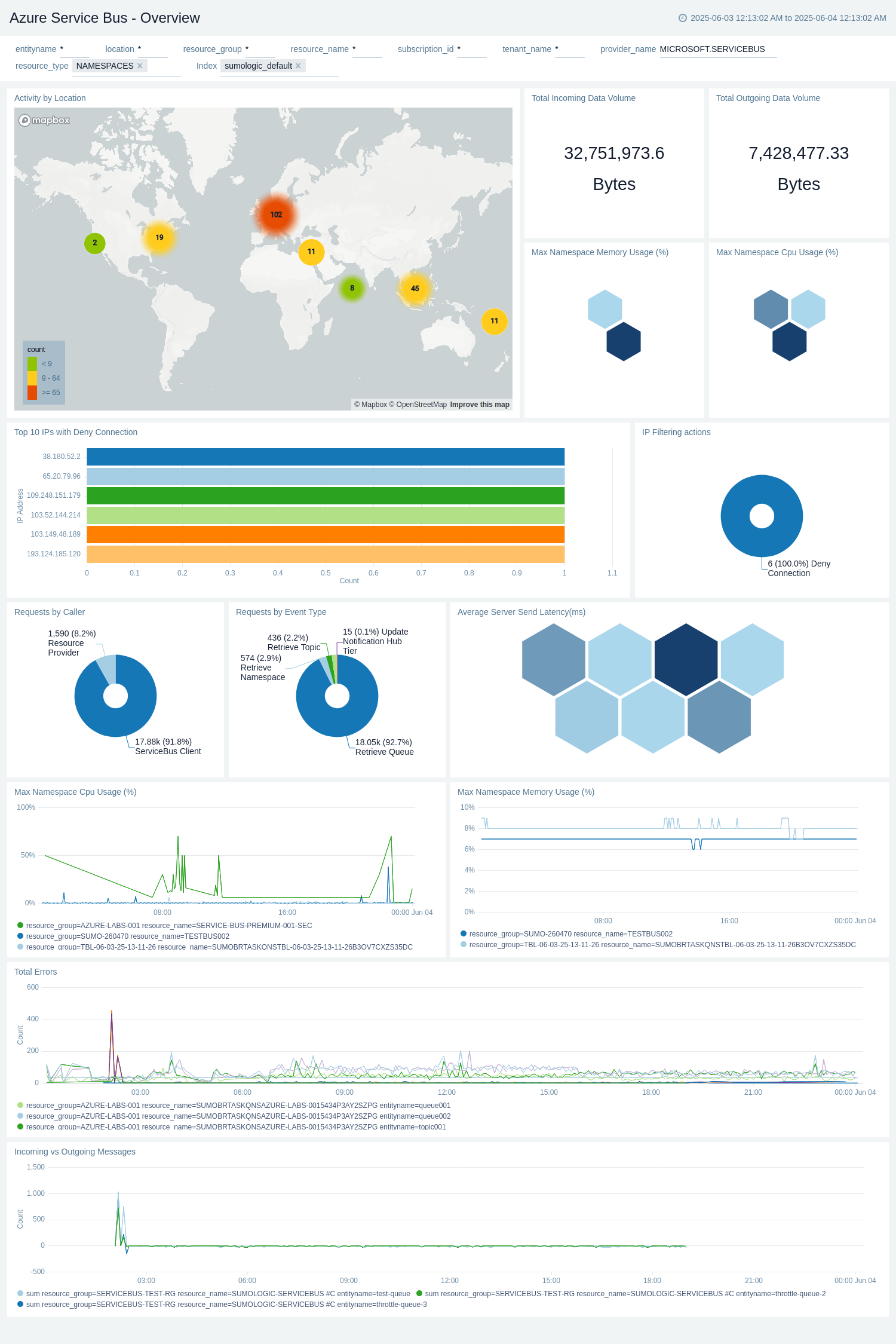
Administrative Operations
The Azure Service Bus - Administrative Operations provides an overview of management activities performed on your Azure Service Bus namespaces.
Use this dashboard to:
- Monitor the distribution of read, write, and delete operations across your service bus namespaces.
- Identify and investigate errors occurring during administrative operations to maintain optimal service bus configuration.
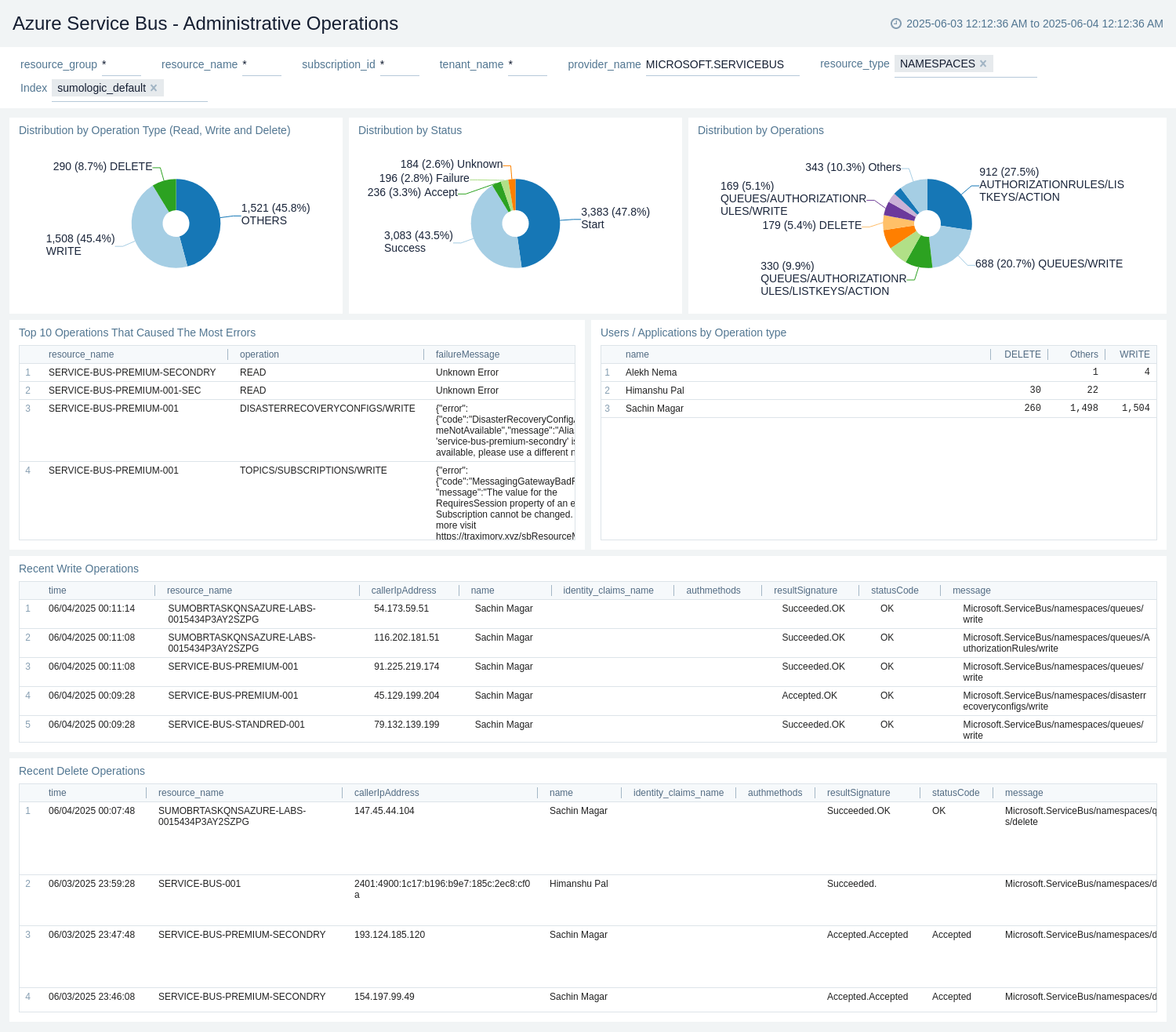
Errors
The Azure Service Bus - Errors provides details on various error types, failed operations, and error messages related to Azure Service Bus.
Use this dashboard to:
- Identify and troubleshoot common error patterns by analyzing the trend of user errors and server errors.
- Monitor message processing issues by tracking dead-lettered and abandoned messages over time.
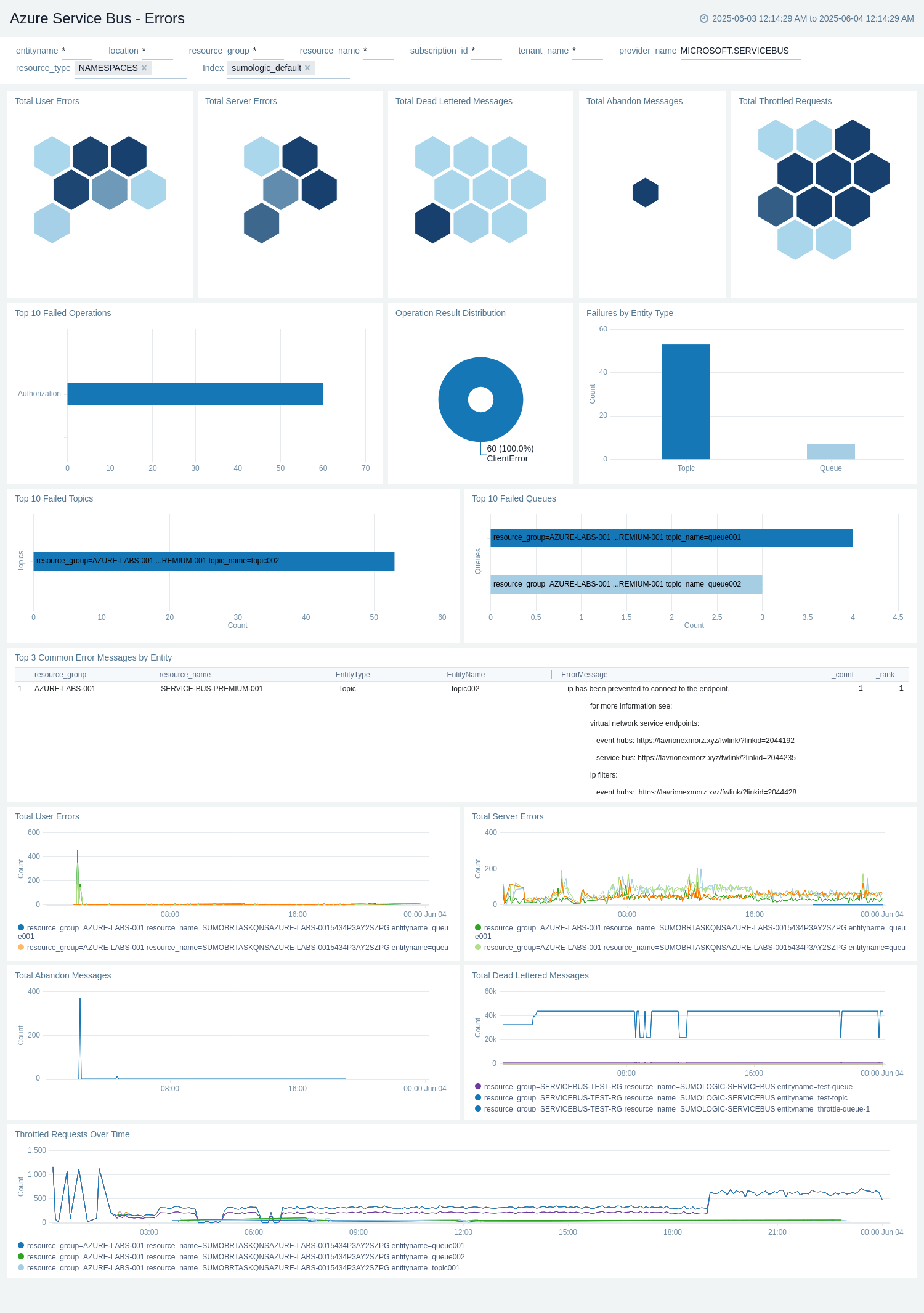
Messages
The Azure Service Bus - Messages provides a detailed view of message flow and status within your Azure Service Bus namespaces.
Use this dashboard to:
- Monitor the volume and status of messages across different categories like active, completed, and abandoned messages.
- Identify potential bottlenecks by comparing incoming and outgoing message rates.
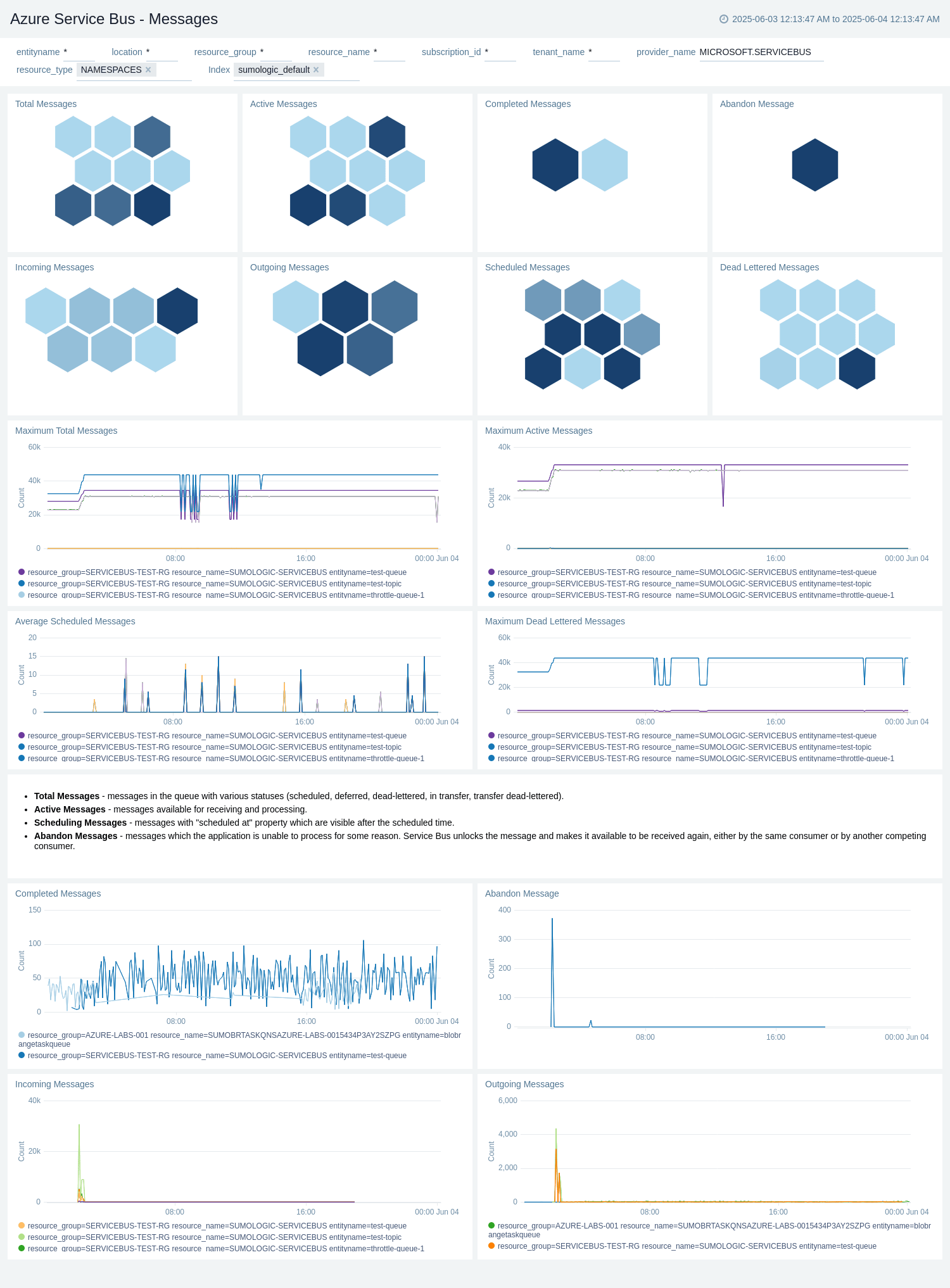
Policy and Recommendation
The Azure Service Bus - Policy and Recommendation provides information on policy enforcement and recommendations for your Azure Service Bus namespaces.
Use this dashboard to:
- Review policy success and failure events to ensure proper policy enforcement and security.
- Identify recommendations to improve the performance and security of your Service Bus instances.
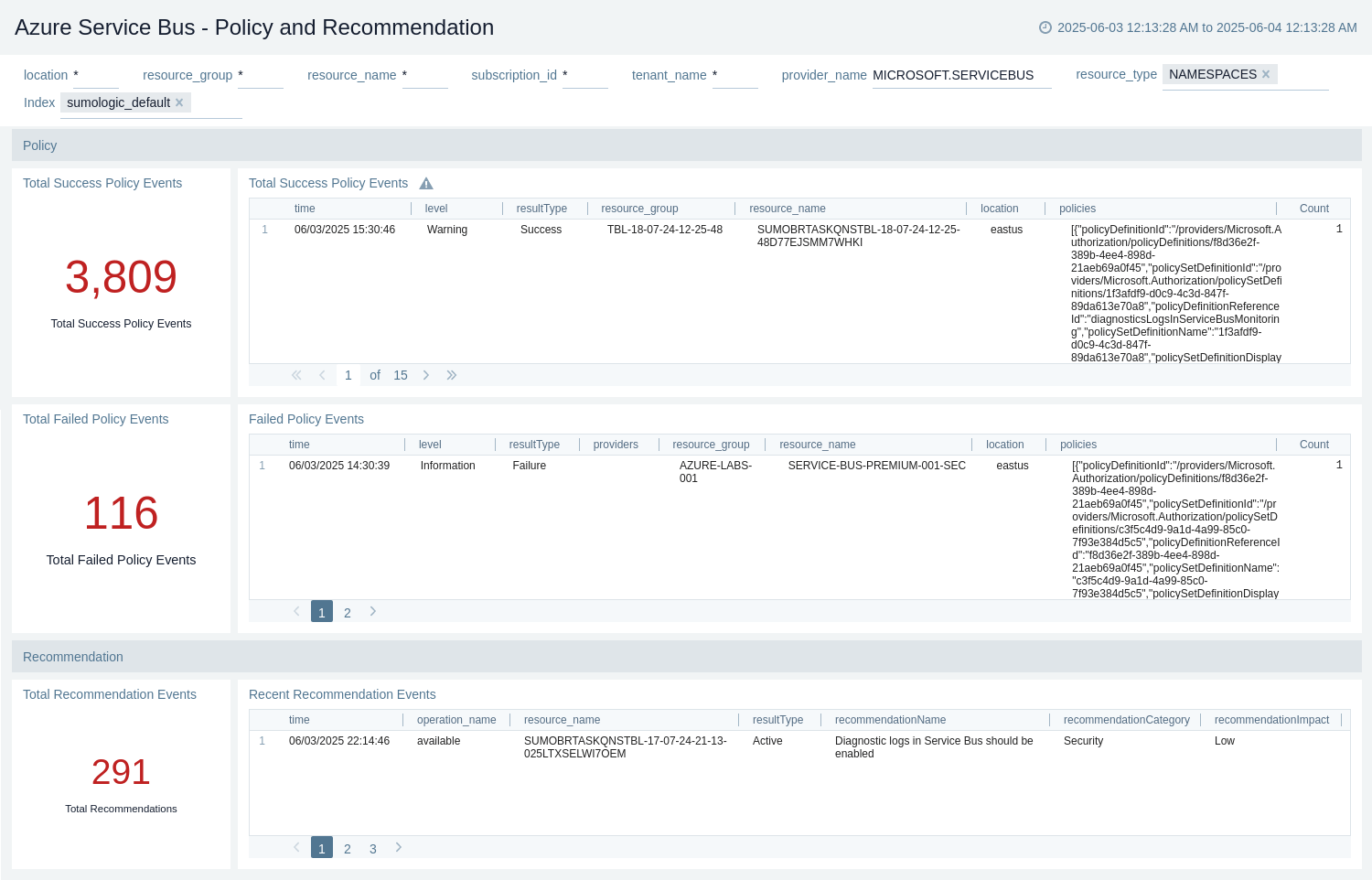
Traffic
The Azure Service Bus - Traffic provides insights into the network traffic and connections of your Azure Service Bus namespaces.
Use this dashboard to:
- Track active connections and analyze connection patterns over time.
- Monitor server send latency and identify any performance issues affecting message delivery.
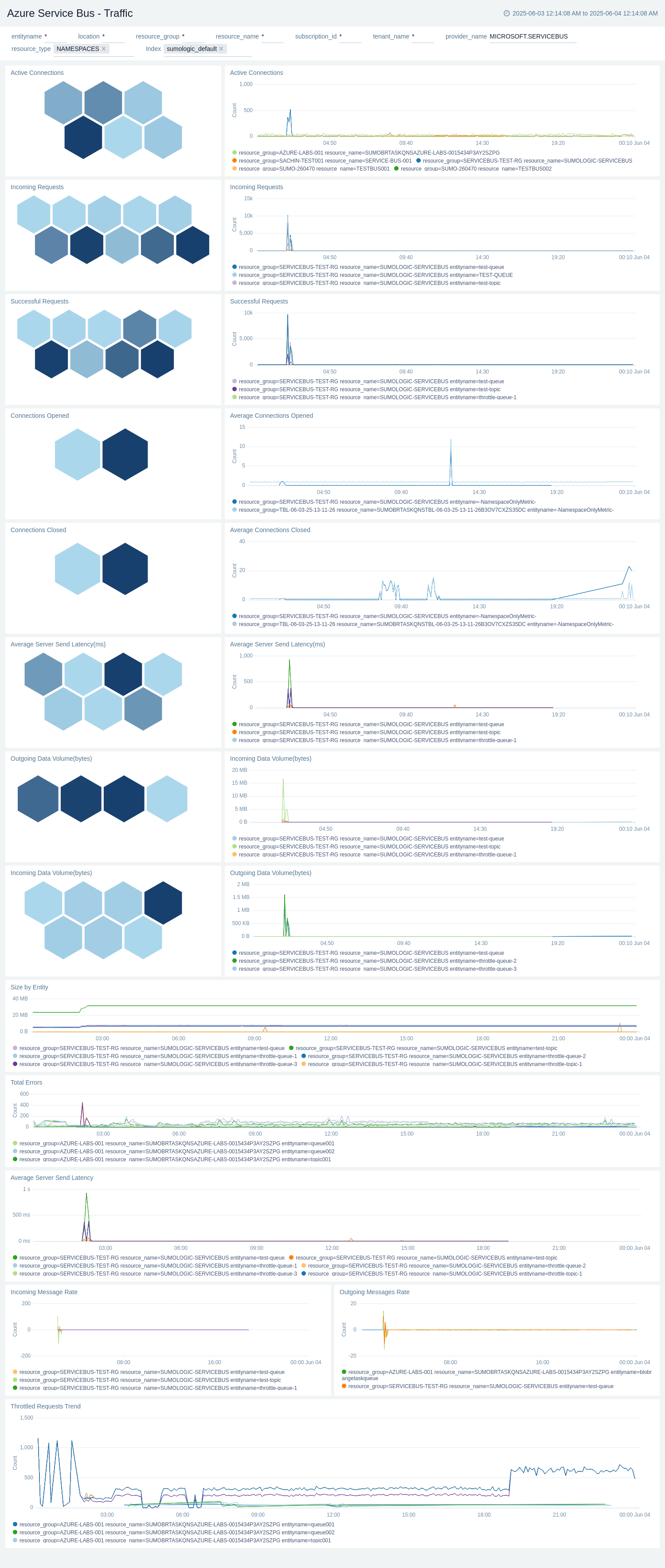
Create monitors for Azure Service Bus App
From your App Catalog:
- From the Sumo Logic navigation, select App Catalog.
- In the Search Apps field, search for and then select your app.
- Make sure the app is installed.
- Navigate to What's Included tab and scroll down to the Monitors section.
- Click Create next to the pre-configured monitors. In the create monitors window, adjust the trigger conditions and notifications settings based on your requirements.
- Scroll down to Monitor Details.
- Under Location click on New Folder.
note
By default, monitor will be saved in the root folder. So to make the maintenance easier, create a new folder in the location of your choice.
- Enter Folder Name. Folder Description is optional.
tip
Using app version in the folder name will be helpful to determine the versioning for future updates.
- Click Create. Once the folder is created, click on Save.
Azure Service Bus Alerts
These alerts are metrics-based and will work for all Azure Service Bus.
| Name | Description | Alert Condition | Recover Condition |
|---|---|---|---|
Azure Service Bus - High Count of Active Messages | This alert is triggered when the active message count is greater than 5000. | Count > 5000 | Count < = 5000 |
Azure Service Bus - High Count of Dead-lettered Messages | This alert is triggered when the dead- lettered message count greater than 50. | Count > 50 | Count < = 50 |
Azure Service Bus - High Count of Messages (Overall) | This alert is triggered when the messages count (active, dead-lettered, scheduled) is greater than 5000. | Count > 5000 | Count < = 5000 |
Azure Service Bus - High CPU Utilization (Premium SKU) | This alert is triggered when the CPU usage percentage is greater than 85. Also, a warning type alert will be triggered when the CPU usage percentage greater than 80. | Count > 85 | Count < = 85 |
Azure Service Bus - High Size Consumption | This alert is triggered when the average size is greater than 3 GB. Also, a warning type alert will be triggered when the average size is greater than 1 GB. | Count > 3 | Count < = 3 |
Upgrade/Downgrade the Azure Service Bus app (optional)
To update the app, do the following:
Next-Gen App: To install or update the app, you must be an account administrator or a user with Manage Apps, Manage Monitors, Manage Fields, Manage Metric Rules, and Manage Collectors capabilities depending upon the different content types part of the app.
- Select App Catalog.
- In the Search Apps field, search for and then select your app.
Optionally, you can identify apps that can be upgraded in the Upgrade available section. - To upgrade the app, select Upgrade from the Manage dropdown.
- If the upgrade does not have any configuration or property changes, you will be redirected to the Preview & Done section.
- If the upgrade has any configuration or property changes, you will be redirected to the Setup Data page.
- In the Configure section of your respective app, complete the following fields.
- Field Name. If you already have collectors and sources set up, select the configured metadata field name (eg _sourcecategory) or specify other custom metadata (eg: _collector) along with its metadata Field Value.
- Click Next. You will be redirected to the Preview & Done section.
Post-update
Your upgraded app will be installed in the Installed Apps folder and dashboard panels will start to fill automatically.
See our Release Notes changelog for new updates in the app.
To revert the app to a previous version, do the following:
- Select App Catalog.
- In the Search Apps field, search for and then select your app.
- To version down the app, select Revert to < previous version of your app > from the Manage dropdown.
Uninstalling the Azure Service Bus app (optional)
To uninstall the app, do the following:
- Select App Catalog.
- In the 🔎 Search Apps field, run a search for your desired app, then select it.
- Click Uninstall.
Troubleshooting
Metrics collection via Azure Metrics Source
To troubleshoot metrics collection via Azure Metrics Source, follow the instructions in Troubleshooting Azure Metrics Source.
Additional resources
- Blog: Azure monitoring and troubleshooting
- Glossary: Microsoft Azure